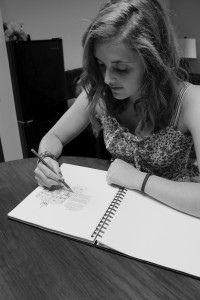Erin Flom, Guest Writer
Earning required art credits can be difficult for some students, especially if they don’t perceive themselves as creative or artistic; however, taking an art class can lead to a new passion, and doesn’t always require traditional artistic talent.
Graduate student Alliy Green is studying for her degree in education. As an undergraduate, she originally planned to be an English teacher.
During her first year, though, Green took an art history class with professor Heather Mathews.
“I always thought ‘if you can’t draw, don’t be an artist,’ but Heather challenged that idea,” Green said.
After that class, Green was inspired to pursue a Bachelor of Fine Arts. Green took her first formal art class in college and graduated with a concentration in ceramics.
Now, as a student teacher at Jason Lee Middle School, she’s helping her students realize that art is a form of expression that anyone can do.
“[Students] don’t have to have artistic talent to get messy and have fun,” Green said.
Professor JP Avila, chair of the Department of Art and Design and a professor of graphic design, describes art classes as a great way to try new things and open up to new experiences. He argues that if students don’t take an art class, they’re missing out on a new perspective. Just like any other class, art requires you to view the world in a new way, he said.
Junior Bradford Lum said that he sees life in pictures. After switching from computer science to business, Lum finally arrived at photography as his major. Although he’s always been passionate about photography, it wasn’t until he took Photography 1 at Pacific Lutheran University that he realized his love for art.
Lum said that photography is one of the easiest art forms to get into. His professors were also supportive.
“Most of the art professors care about what you’re producing,” Lum said. “They’ll approach you and say ‘let’s work on your stuff.’”
Art is also a great medium for self-expression. Junior Jasper Sortun took Photography 1 in her first year. As their final project, the students were required to take a self-portrait and emulate another photographer’s style.

Sortun chose to dress in a creepy, doll-like way, surprising her professor with her prints.
“I just remember [professor] Geller coming up to me and saying, ‘I had no idea you were weird!’” Sortun said.
Avila said Photography 1, along with Ceramics 1, are feeder classes; they make students realize they enjoy art and these classes usually lead them to other art classes. Lum also advises students to take Drawing 1 after as it’s a prerequisite for many other art classes.
Avila said design is applicable in everyday life.
Senior Rachel Althauser realized this when she studied abroad in Dubai with Avila’s class. At the time, Althauser was a Communication major with a Studio Art minor.
“I saw it would be beneficial for my advertising and PR emphasis,” Althauser said.
She realized it could help her stand out in the future. She is now double-majoring in Communication and Graphic Design.
Art requires a different mindset and set of skills, like learning how to spin a potter’s wheel or using breathing techniques to play an instrument.
Avila related it to physical education or kinesiology.
“You learn your body and build muscle memory,” Avila said.
Professor Zachary Lyman said music can be academic and artistic. When learning how to read music, students will find there are elements of math in it.
In Music Fundamentals 1 and 2, students learn the basics of music, and since this class starts from ground zero, Lyman said, students don’t need any background in music.
The music ensembles at PLU hold auditions which are open to all students. Auditions are held during the fall, and the most qualified players are accepted, no matter their major. Private lessons are also open to any student, even if they’ve never played an instrument.
Sophomore Margot Fresquez took Intro to Theatre during J-Term last year. Learning about the history of the art as well as some acting reminded her of how fun acting was. She said her last experience with theatre was in high school and taking this class allowed her to think about her talents.
Although she hasn’t decided on a major, Fresquez is able to see how theatre can relate to her current classes.
An art class is a great place for students to get outside their comfort zones and learn something new.
Students should remember it’s OK to fail, Avila said, and shouldn’t be afraid if it doesn’t work the first time.



















